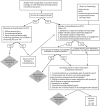Medical retirement from sport after concussions: A practical guide for a difficult discussion
- PMID: 29517059
- PMCID: PMC5839677
- DOI: 10.1212/CPJ.0000000000000424
Medical retirement from sport after concussions: A practical guide for a difficult discussion
Abstract
Purpose of review: In patients with a considerable history of sports-related concussion, the decision of when to discontinue participation in sports due to medical concerns including neurologic disorders has potentially life-altering consequences, especially for young athletes, and merits a comprehensive evaluation involving nuanced discussion. Few resources exist to aid the sports medicine provider.
Recent findings: In this narrative review, we describe 10 prototypical vignettes based upon the authors' collective experience in concussion management and propose an algorithm to help clinicians navigate retirement discussions. Issues for consideration include absolute and relative contraindications to return to sport, ranging from clinical or radiographic evidence of lasting neurologic injury to prolonged concussion recovery periods or reduced injury threshold to patient-centered factors including personal identity through sport, financial motivations, and navigating uncertainty in the context of long-term risks.
Summary: The authors propose a novel treatment algorithm based on real patient cases to guide medical retirement decisions after concussion in sport.
Figures


Comment in
- Neurol Clin Pract. 8(1):6.
References
-
- Noble JM, Hesdorffer DC. Sport-related concussions: a review of epidemiology, challenges in diagnosis, and potential risk factors. Neuropsychol Rev 2013;23:273–284. - PubMed
-
- Wiebe DJ, Comstock RD, Nance ML. Concussion research: a public health priority. Inj Prev 2011;17:69–70. - PubMed
-
- Castile L, Collins CL, McIlvain NM, Comstock RD. The epidemiology of new versus recurrent sports concussions among high school athletes, 2005–2010. Br J Sports Med 2012;46:603–610. - PubMed
-
- Slobounov S, Slobounov E, Sebastianelli W, Cao C, Newell K. Differential rate of recovery in athletes after first and second concussion episodes. Neurosurgery 2007;61:338–344. - PubMed
Publication types
LinkOut - more resources
Full Text Sources
Other Literature Sources
Research Materials
